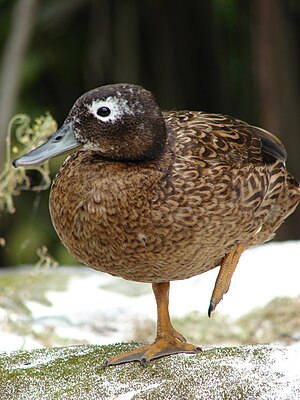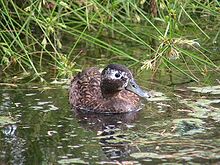Laysan duck
| Laysan duck | ||||||||||||
|---|---|---|---|---|---|---|---|---|---|---|---|---|

Laysan Duck ( Anas laysanensis ) |
||||||||||||
| Systematics | ||||||||||||
|
||||||||||||
| Scientific name | ||||||||||||
| Anas laysanensis | ||||||||||||
| Rothschild , 1892 |
The Laysan Duck (zool .: Anas laysanensis ) is a kind from the family of ducks that only on the island of Laysan , Hawaii occurs and there is endemic is. It is considered closely related to the mallard and is occasionally considered an island breed of this species. Just as the Bernie pension , the white-winged duck and the Madagascar duck it is one of the ducks birds whose existence is considered threatened.
Appearance
Laysan ducks are very small ducks (420–500 g, length 38–43 cm) that have a predominantly dark chestnut colored body plumage. The neck and head are black-brown. The sexual dimorphism is relatively low - in the male only the eye region and in the female face, throat and neck are interspersed with white feathers. In some drakes, there is also a black-green head plumage. Males also have bright orange feet, while the females are more reddish-brown in color.
Distribution area
The Laysan Duck is an endemic island breed that only naturally occurred on the 350-hectare island of Laysan for a long period of time that cannot be precisely determined. Recent subfossil finds suggest that the Laysan duck was originally distributed across the entire Hawaiian archipelago. Historically, however, the Laysanente was only observed outside of Laysan on Lisianski Island, almost 1,700 kilometers west of Honolulu, and was no longer found there from 1834. However, this evidence of distribution outside Laysan during the last few centuries is not accepted by all authors. If this evidence is accepted, it leads to the conclusion that the Laysanente was found on other islands in the Hawaiian archipelago and is not as ecologically specialized as it has always been assumed.
Habitat and way of life
The population of ducks focused until recently on a brackish lagoon of the island Laysan. There they mainly fed on salt flies and small shrimp and mostly looked for food at night in a single salt water lagoon in the middle of the island. It flies extremely seldom, although it is capable of it. During the evening and morning hours you can watch them foraging for food. It lives mainly on land and water plants and also eats caterpillars of some moth species that are found on Laysan.
Laysan ducks nest under bushes along the lagoon coast. The clutch consists of 5 to 7 large greenish eggs. They are incubated for about 26 days until the chicks, which weigh about 30 grams, hatch.
Protective measures
Even if the Laysanente is considered to be endangered overall due to the low population of only 500 to 700 animals, there has been a significant recovery in the last few decades.
The number of Laysan ducks had fallen sharply due to the high hunting pressure from guano gatherers and rabbits introduced on Laysan. In 1930 there was only one female on the island of Laysan in addition to several males, so one had to assume that this species would become extinct in the near future. The first clutch that the remaining female laid in 1930 was discovered and eaten by a bristle curlew on the move. However, chicks hatched from the secondary clutch that the female laid a few weeks later. Since the guano mining had meanwhile been stopped on the island and no more people lived on this island, there was a significant recovery in the following years. This development was supported by the raising of the island to a bird sanctuary and the destruction of the rabbits found on the island . As early as the 1950s, there were enough ducks on the island to raise some in captivity. At the beginning of the 1990s, more than 800 individuals lived on Laysan again. In 1993 an extreme drought resulted in losses. At the same time, numerous ducks fell ill with botulism , so that the population collapsed to only 82 individuals.
To prevent future population collapses caused by such extreme events, Laysanents were relocated to the Midway Islands in 2004. Initially 42 Laysanents were released on this also protected atoll. More than fifty chicks hatched there in the first breeding season. In 2015 the Laysanente was also settled on the Kure Atoll . A settlement on Lisianski is also planned.
Laysan ducks as ornamental poultry
In addition to the Honolulu Zoo , the British Wildfowl Trust was also involved in maintaining this species of duck, which began in the 1960s . The Laysan duck is now considered an easy-to-keep species that is also suitable for keeping in small enclosures. It is recommended, however, to keep the animals in aviaries , as there is a risk of hybridization with mallards.
literature
- T. Bartlett: Ducks And Geese - A Guide To Management. The Crowood Press, 2002, ISBN 1-85223-650-7
- Dominic Couzens : Rare Birds - Survivors, Evolution Losers and the Lost. Haupt Verlag, Bern 2011, ISBN 9783258076294 .
- Hartmut Kolbe: The world's ducks. Ulmer Verlag 1999, ISBN 3-8001-7442-1
- Eric A. VanderWerf: Hawaiian Bird Conservation Action Plan. Pacific Rim Conservation, Honolulu, HI and US Fish and Wildlife Service, Portland ( pdf ), Chapter Laysan Duck ( pdf )
Web links
- Anas laysanensis in the endangered Red List species the IUCN 2008. Posted by: BirdLife International, 2008. Accessed January 31 of 2009.


